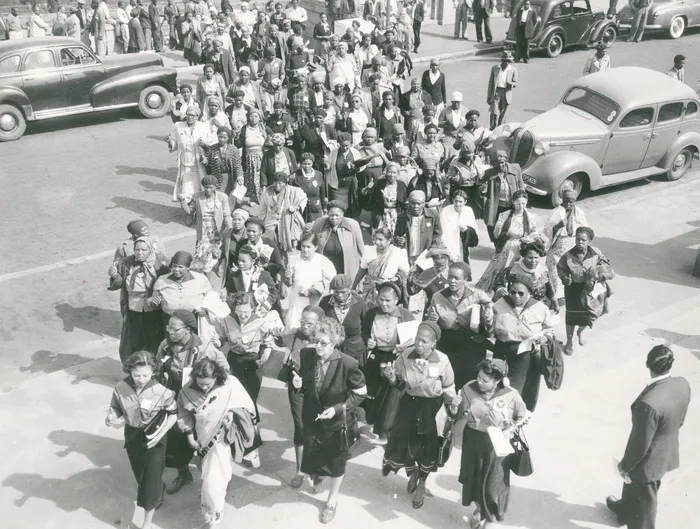Emulating the women of 1956 would help build a united SA

More than 20,000 women march to the Union Buildings on August 9, 1956 in South Africa. Leading the women are, front from left, Sophie Williams, Raheema Moosa, Helen Joseph and Lilian Ngoyi and Lilian Diedericks. Picture: Independent Archives
By Ela Gandhi
As we prepare to wish our woman friends Happy Women’s Day on August 9, it is a time to contemplate what we are celebrating.
Is national Women’s Day in South Africa the same as Mother’s Day? Is it like a birthday or a festive occasion when we present gifts? Is it like International Women’s Day? These are questions many people ask.
In thinking about the important days, I see Mother’s Day as distinct from Women’s Day as the former honours the role that a mother plays in one’s life.
A birthday is linked to age, growth and development. The celebration of birthdays reminds us that, as we grow, we are expected to become more responsible.
International Women’s Day is about the rights of women and their status, particularly in the workplace.
National Women’s Day is an important day for South Africans because on this day we recall and celebrate the bravery of our women who marched to the Union Buildings in Pretoria on August 9, 1956.
It was on August 9, 1942, that Kasturba Gandhi, my grandmother, was arrested while on her way to address a meeting in the aftermath of the quit India resolution taken by the Indian National Congress. She was held in detention until February 22, 1944, when she died in prison with Mahatma Gandhi beside her.
During the ’50s, women in South Africa suffered many injustices. Many jobs, professions and senior positions were inaccessible to them. Women received less pay than men for the same jobs. Society discriminated against women with the expectation that women would take full responsibility for household chores, child and elderly care in the home and pander to the needs of the men in the family. In general, her needs were not regarded as important.
Today, there are laws prohibiting discrimination against women.
Our Constitution protects women against any form of discrimination. Women are slowly making strides in securing top positions in the government, industry and academia.
But has society’s attitude changed? The high rate of gender-based violence, femicide and female-headed households indicate that many social notions continue to thrive and are based on the age-old patriarchal system that continues to entrench itself in our hearts and minds.
In 1956, 20 000 women gathered in front of the Union Buildings. They braved the state of emergency and ingeniously defied the restrictions and impediments that the apartheid government placed before them. The women shattered the myth of apartheid.
They organised women across race, religion and class divides to come together in a show of solidarity and dignity. Defiant yet peaceful, they stood in protest against the pass laws that applied to black South Africans. Women of all races came together and stood in solidarity in front of the Union Buildings.
Today, we are struggling to seek that kind of solidarity. We are struggling to build social cohesion and a united South African national identity. We are increasingly finding ourselves divided along not only racial barriers but also along religious, ethnic and class differences.
In 1954, women united in a federation of South African women, bringing together women from all walks of life and all races and religions. That is why they were able to mobilise women of all races in the march.
Today, we remain fragmented. We do not have such a federation. The non-racial character of our social and political order is fast disappearing. Our dissatisfaction is expressed in violent and undisciplined ways. Efforts at unity are at an all-time low, with the community receding into compartmentalisation.
Among the organisers in 1956 were Ma Lillian Ngoyi, Helen Joseph, Sophia Williams and Rahima Moosa. What can we learn from them?
Unity and solidarity
The first lesson is the fact that although the pass laws applied only to black women, women of all races banded together in solidarity with one another.
Unity and solidarity were not created overnight but through the work done by the federation that brought women of all races, faiths and ethnic divisions into one organisation, working together to address the needs of all.
Courage, resilience, ingenuity
A second significant lesson is the courage, resilience and ingenuity that were displayed by the women as they defied the emergency regulations to participate in the march.
Pregnant women and those carrying babies came, despite their families warning them about taking part. To overcome the emergency regulations, they came together, from different directions and in little groups of three and four and stood in silence in front of the Union Buildings.
Peaceful and dignified protest
The third significance of the day is the respect women earned from the broader community by their dignified disciplined manner of gathering, executing their responsibility and dispersing without any stampede or indiscipline. Peaceful yet determined, they displayed their united force with dignity and courage. Nothing was broken, no one was injured and there was no noisy bantering. It was impressive! It won the sympathy of the hardest heart.
On August 9, we remember the lessons these brave women of 1956 taught us – everyone is a leader. We can honour them only by trying to emulate the legacy they have left for us.
* Dr Ela Gandhi is a Peace activist
** The views expressed in this article are the writer’s and do not necessarily reflect the views of The African
Related Topics: